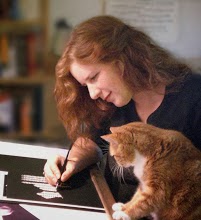One of the pastel artists I most admire, Diane Ponting, has a painting done as a trompe l'oeil on newsprint. I happened to have a local paper laying around and there is never not a cup of tea or coffee on my desk or by my easel - so there I had my subject.
Attempt #1:

Now if you've ever worked with pastel you may see the problems inherent in this little project.
If you haven't worked with pastel - then know that some of the best (and most expensive) papers for pastel painting are sanded (they are essentially fine grit sandpaper - only made of better materials). You can imagine how that is the complete polar opposite of newsprint. The result is that it was diffcult to work on - I could only put limited layers of pigment on and the paper was constantly threatening to tear.
Attempt #2:
This time I primed the paper with workable fixative. This is a spray product used to coat the surface of artwork. It also will, to a certain degree, restore the 'tooth' of the paper - giving it a little more grit. I don't typically use this fixative overtop the pastel as it does darken the colors, in this case it was used on the blank paper *before* the pastel was applied.

I didn't really see much difference in texture - it was still a pain to work on. Adding the bagel was a bad idea too - it is relatively easy to do smooth surfaces (the liquid, ceramic, glass, metal) with few layers, but the organic bagel/cream cheese looks very 'painterly'. It's a lovely bagel (and it tasted great!) but not the hyperrealistic painting that I'm aiming for with a trompe l'oeil. I'll keep that in mind next time. This time the paper did tear - I've cropped it out, but working in the upper right (to create the illusion of warped text under the glass plate) proved to be a bit much for the poor paper.
All in all a good second painting, but still too tricky to do a really good job.
Other concerns:
So by this point I've become totally captivated by this idea - and now that it's taken a step beyond being a quick sketch for fun another important characteristic of newsprint surfaces has arisen... its archival qualities (or rather, its lack of them).
There's not too many surfaces out there with as poor longevity as newsprint. It yellows, it cracks. The aging process of paper is due to a combination of factors including acidity and wood pulp content - both of which are prominent in newspaper.
Despite all of that I am a crazy bugger and part of what appeals to me about this art is the fact that it's done on a real, actual local newspaper - so it's worth a bit of working around. Before the next stage I'm going to focus on bolstering up this paper....
Step 1: Acid buffer. Each sheet gets coated on both sides with a spray acid buffer.
Step 2: UV resistant matte coating. The visible surfaces get a few light coats of UV blocker. I prefer not to use this spray over the pastel, but in this case the paper is my prime concern so it is being treated under the painting that will eventually happen. (This protection could be further augmented by framing under UV blocking glass and hanging the final painting out of direct sunlight).
Step 3:Clear Colourfix primer. The newsprint is primed with this material - essentially a gooey clear substance with sandy grit. It is used to prepare surfaces for pastel painting and a colleague suggested trying it on the newsprint... here goes!
Step 4: The painting.
Attempt #3:

Getting better.
This surface was much easier to work on - which allowed me to get more layers of color and therefore more depth to the painting. The rim of the cup is off, but I like the effect of the submerged part of the teabag and I managed to get the spoon proportions better this time. This was done using a combination of pastel sticks and pencils. If you look closely you can see some streaks - that is from applying the gesso with a foam brush. In the future I'll use a foam roller to apply the gesso more evenly.
Now that I have a handle on manipulating this new surface it's time to try some different subject matter - check back for Part 2 and some new art to be posted.













